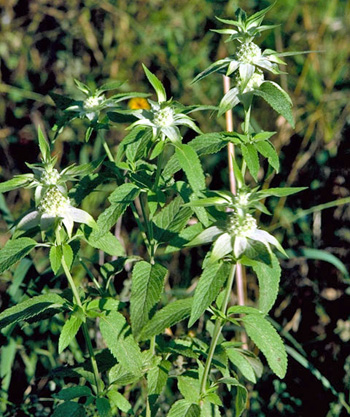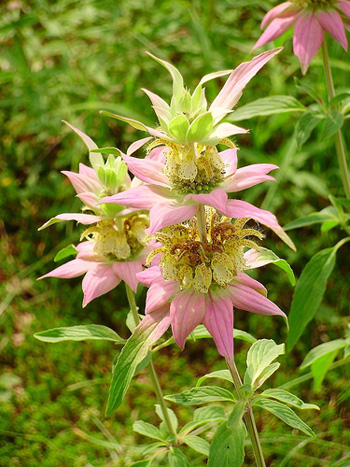Contents:
Common Names | Parts Usually Used | Plant(s) & Culture | Where Found | Medicinal Properties | Biochemical Information
Uses | Formulas or Dosages | Bibliography
Scientific Names

- Monarda punctata L.
- Labiatae
- Mint family
Common Names
- American horsemint
- Monarda
Parts Usually Used
Leaves, flowering tops
Back to Top
Description of Plant(s) and Culture

Horsemint is a native strongly aromatic biennial or a short-lived perennial plant 1-4 feet tall; the branched, round four-angled, stem bears opposite, lanceolate, downy leaves dotted with small depressions. The two-lipped flowers, like gaping mouths, are yellowish with red spots and grow in successive axillary whorls subtended by large, white-lilac, lance-shaped bracts around them. July to October.
Other varieties: Oswego tea (M. didyma) and Wild bergamot (M. fistulosa); also called horsemint (M arvensis) which is more common in India.
Back to Top
Where Found
Found mainly in the eastern and central United States. Likes dry places and on sandy soils; on the coastal plain from New Jersey to Florida and Texas, also further west from Michigan and Minnesota south to Missouri.
Back to Top
Medicinal Properties
Cardiac, carminative, diaphoretic, diuretic, sudorific, emmenagogue, aromatic, stomachic, calmative, mild alterative
Back to Top
Biochemical Information
Volatile oil, menthol, menthone, d-iperitone, lemonene, hexenolphenylacetate, ethylamyulacarbinol, neomenthol
Back to Top
Uses
Horsemint tea can be taken for flatulent colic, suppressed urine, diarrhea, rheumatism, and digestive and other stomach problems such as nausea and vomiting. Native Americans used the plant for fever, flu, catarrhs, chills, decreased menstrual flow, and inflammations. One tribe drank a cold extract to relieve backache, and another to stimulate heart action. The oil derived from the leaves promote sweating when rubbed on. Oil high in thymol expels worms. Thymol, now manufactured synthetically, was once commercially derived from thyme (Thymus species).
During World War I, commercial thyme fields were destroyed in Europe and horsemint was grown in the United States as a substitute source of thymol.
Horsemint is efficient in the control of vomiting due to exhaustion, persistent nausea with flatulence, or vomiting of alcoholics in whom it will impart a temporary tone to the stomach.
Back to Top
Formulas or Dosages
Infusion: steep 1 tsp. leaves or tops in 1 cup water. Take 1-2 cups a day.
Oil of horsemint, diluted with soap, can be rubbed on to alleviate the pains of rheumatism and backache.
Take 10-30 drops of the tincture daily in a glass of water.
Back to Top
Bibliography
![]() Back to Eden
Back to Eden, by Jethro Kloss; Back to Eden Publishing Co., Loma Linda, CA 92354, Original copyright 1939, revised edition 1994
![]() The Herb Book
The Herb Book, by John Lust, Bantam Books, 666 Fifth Avenue, New York, NY. copyright 1974.
![]() Indian Herbalogy of North America
Indian Herbalogy of North America, by Alma R. Hutchens, Shambala Publications, Inc., Horticultural Hall, 300 Massachusetts Avenue, Boston, Massachusetts 02115, 1973
![]() Eastern/Central Medicinal Plants
Eastern/Central Medicinal Plants, by Steven Foster and James A. Duke., Houghton Mifflin Company, 215 Park Avenue South, New York, NY 10000
![]() Planetary Herbology
Planetary Herbology, by Michael Tierra, C.A., N.D., O.M.D., Lotus Press, PO Box 325, Twin Lakes. WI 53181., Copyright 1988, published 1992
![]() American Folk Medicine
American Folk Medicine, by Clarence Meyer, Meyerbooks, publisher, PO Box 427, Glenwood, Illinois 60425, 1973
![]() Webster’s New World Dictionary
Webster’s New World Dictionary, Third College Edition, Victoria Neufeldt, Editor in Chief, New World Dictionaries: A Division of Simon & Schuster, Inc., 15 Columbus Circle, New York, NY 10023
 How Indians Use Wild Plants for Food, Medicine & Crafts
How Indians Use Wild Plants for Food, Medicine & Crafts, by Frances Densmore, Dover Publications, Inc., 180 Varick Street, New York, NY 10014, first printed by the United States Government Printing Office, Washington, in 1928, this Dover edition 1974
![]() The Yoga of Herbs: An Ayurvedic Guide to Herbal Medicine
The Yoga of Herbs: An Ayurvedic Guide to Herbal Medicine, by Dr. David Frawley & Dr. Vasant Lad, Lotus Press, Twin Lakes, Wisconsin, Second edition, 1988.
 An Instant Guide to Medicinal Plants
An Instant Guide to Medicinal Plants, by Pamela Forey and Ruth Lindsay, Crescent Books (January 27, 1992).
 The Magic of Herbs in Daily Living
The Magic of Herbs in Daily Living, by Richard Lucas, Parker Publishing Co. (1988).
